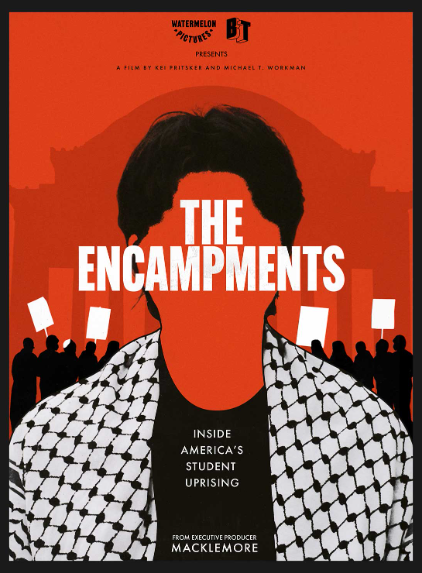The Encampments: Student Resilience for Palestine

By: Rena Elhessen / Arab America Contributing Writer
It has been a year since the nation witnessed the rise of student protests against the University’s fiscal involvement in the on-going Israel-Hamas war. Following continued discontent with university policy and investments, students turned to encampments as a form of protest. The first of these encampments emerged at Columbia University and gained traction internationally. The administrative bodies of these universities responded with violence, calling police departments to break up these encampments. A year later, Watermelon Pictures has released a documentary of these events. The Encampments follow the student-led protests at their point of origin, Columbia University. In one word, this documentary is impactful, leaving audiences inspired.
Why Encampments?
Historically, universities have been at the forefront of protests for change. During the height of the Vietnam War, college campuses saw an outburst of student protests nationally. These protests were against the university’s role in drafting students, demanding a U.S. withdrawal from Vietnam. In mirroring history, the encampments of Columbia University began due to American universities’ involvement in the Israeli war on Gaza.
The documentary begins by interviewing the students of Columbia University who organized these encampments. The reasoning for the protests is made clear: Ivy League universities continue to profit off the war through direct or third-party investments in weapons manufacturers. Why would these institutions, which prioritize education, be investing in weapons manufacturing?
Outraged by the knowledge that their tuition contributes to the death of Palestinian lives, students began to protest. These peaceful protests demanded that the university divest from federal weapons manufacturers, such as Lockheed Martin. After protesting for months with demands unmet and ignored, student protesters decided to encamp on school grounds to force the school faculty to recognize their demands.
The Encampments
The documentary follows the first encampment at Columbia University in New York, which would spark the emergence of others nationwide. This documentary is told from the perspectives of the encampment student organizers, Mahmoud Kahlil and Sueda. By telling the story through this angle, the film aims to separate the encampments from the anti-Semitic and anti-Israeli affiliation given by the media. Instead, the film focuses on the statement of protesters to fight for Palestinian lives and justice.
From the first day of the Columbia encampment, it was a place of student unity. Over 100 student groups were coordinating 24-hour programming to uplift students. Those participating in the encampment would enter a safe space of interfaith practices, musical performances, and free food and supplies. This space should have been seen as uplifting and positive, yet was villainized by Columbia University’s administrators and president, Manouche Shafik.
Government Interference in University Campuses
While students pitched their tents for the ‘Gaza Solidarity Encampment’, President Manouche Shafik was facing Congress. Columbia University’s handling of anti-Semitism on campus had already been called to question. Thus, establishing the political tensions that contributed to the vilification of the encampments. The media and the university’s administration label the encampment as a threat to student and campus safety, allowing for mass arrests.
The social media coverage of these mass arrests sparked national outrage. Inspired by the bravery of students at Columbia University, other institutions adopted the same tactics of protest. Universities across the nation began to set up their encampments, including Brown University, Harvard, MIT, UCLA, and many others.
The documentary then follows the crackdown on these encampments amidst governmental crackdowns on these universities for increased ‘anti-Semitism’. The encampments faced violent community and authoritative opposition for two weeks before their dismantling. This documentary explores the student resilience in the face of oppression, and leaves the audience questioning the media’s perspective in vilifying the twenty-something-year-old students fighting for justice.
University Unrest
The significance of this documentary should not be overlooked. The multiple perspectives of interviewees throughout the documentary force audiences to reconsider their knowledge of the events of the encampments. Most importantly, how the media constructed the narrative of the encampments.
The documentary is presented as a source of research material in unveiling the truth of the encampments, offering live video coverage of the on-campus events and first-person perspectives. Through these perspectives, the documentary contradicts the media’s role in vilifying the encampments. Instead, these encampments were sources of student unity, gaining support from more than just Arab students.
Unfortunately, the government crackdown on the university’s inability to control these encampments pressured the admin and faculty to resort to police presence. Other campus encampments, such as the one found at UCLA, faced violence from community members. Perhaps the most startling question presented in this documentary is why the government and university administration aimed to silence an encampment that promoted cohesive protest.
Controversy Around the Documentary
This documentary had been set to release Fall of 2025; however, recent events in the American political landscape pressured an early release in May 2025. The film highlights the student organizers of the encampment at Columbia University. Among these organizers was Mahmoud Khalil, a permanent resident of the United States who was recently taken into custody by ICE agents.
When the video of his arrest emerged, the creators of the documentary decided to release the film early. Lawsuits continue to emerge in the aftermath of these encampments, each targeting the university’s response to handling these protests. Civil rights organizations have filed lawsuits against Columbia University, arguing for the legality of these encampments.
Want more articles like this? Sign up for our e-newsletter!
Check out our blog here!








